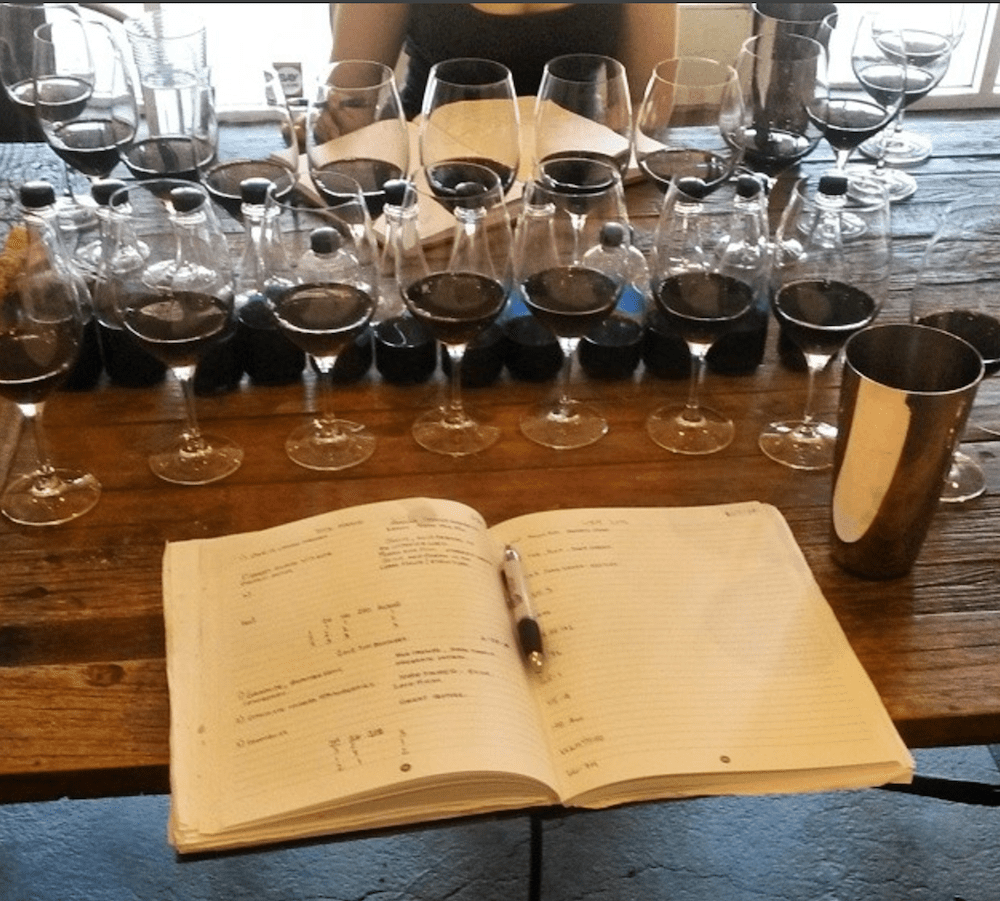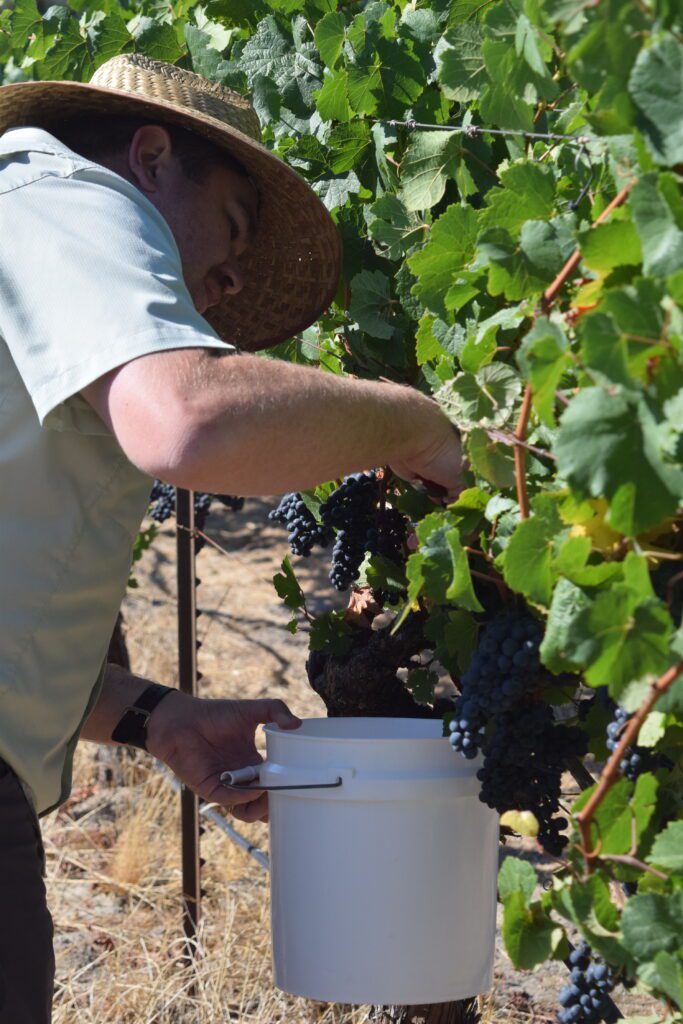
Behind the Blend: Crafting Cuvée Wines
Welcome to Part 2 of our series on Cuvée Wines! In this blog, we’re going into detail about the Donelan wine blending process.
A Fine Example
David Milner, Winemaker at Donelan Family Wines – a winery highly acclaimed for their Syrahs and Rhône-style blends – shares how he approaches cuvée wines at Donelan. Milner refers to four bottles as “purpose-built” cuvée blends and routinely what reviewers love most. They include the:
- Moriah: an old-world style blend made from Syrah, Grenache, and/or Mourvedre, depending on the vintage
- Christine and Keltie: both 100% Syrah blends made from several of the same vineyards, but crafted very differently
- Syrah Grande: a “super cuvée” 100% Syrah blend
At Donelan, the term Cuvée distinguishes their blends from their single-vineyard and estate wines. For example, Cuvée Keltie is a 100% Syrah blend from various vineyards, while Obsidian is 100% Syrah from Obsidian Estate Vineyard. The single-vineyard wines speak to their individual terroir, while the cuvée wines create a special experience that changes each vintage and cannot be replicated.
Says Winery and Vineyard owner Joe Donelan, “We choose sites we love and then let them express themselves.”
The Cuvée Equation
Step 1
Managing the same varietal at different vineyard sites – or terroirs – is the first part of the important equation for crafting a superior cuvée. Because these sites are spread throughout Sonoma County (from the Pacific Coast to the Russian River to the Sonoma/Napa border), Donelan cuvées show the potential of the county as a whole. David Milner spends his time among the grapes all season long to monitor growth behavior and to begin envisioning a path for cuvées later in the season.
Step 2
The second part of the Cuvée equation is managing harvest — where blending decisions are made on-site when the grapes are picked. Since every Donelan cuvée is designed as such (and not made as an afterthought), tonnage is immediately allocated to each potential cuvée style and fermented according to plan. Wines are tasted consistently throughout the winemaking process and elevage so that when the actual blending begins, Milner already has a good idea about which pieces will fit where.

Benchtop Blends
Step 3
Next, comes “the fun part” — the blending trials or the process of experimentation and design. It begins with the creation of “benchtop blends”, which are very small blended samples (think little bottles) that allow the team to blind taste their creation. The Donelan team will make four benchtop blends for each cuvée label (so 4 for Keltie, 4 for Moriah, etc.) and label them A, B, C, and D. Everyone then votes by force ranking them 1-4. This process is repeated up to a dozen times throughout elevage, which is the progression of wine from fermentation to bottling. Once a benchtop blend is unanimously chosen, that becomes the Cuvée that Donelan prepares to make.

Blind blending trials with benchtop blends
For Milner, sometimes there’s a clear path early on to a particular cuvée. Other times there’s not, and many blending trials are required to get it right. The other fun thing about Donelan Cuvées is their composition changes every year. It’s never just 50% of that vineyard and 50% of the other. “It’s vintage dependent,” Milner says. “No rules apply. The goal is just to make the finest wine we can that represents that varietal.”
Donelan Cuvées
So how is it that Milner and his team can craft four very different cuvée wines? In fact, the Cuvée Christine and the Cuvée Keltie contain Syrah fruit from many of the same vineyards, hand-picked from specific rows of grapes. These wines have the same makeup for the most part, but it’s how they’re made that makes them distinctly different.
Keltie and Christine
Cuvée Keltie is high-cluster from isolated shy-bearing sections of the vineyard, made to have much less fruit flavor and more savory qualities: think herbs, leather, smoked meats, and pepper. Meanwhile, Cuvée Christine is all about showing how generous a Sonoma Syrah can be with heavier fruit and rounder tannins. It’s made with lower whole cluster, new oak, and aged for a shorter amount of time. The result is a fruit-forward Syrah: plum, blackberry, ripe cherry, and mulberry are common traits of Christine.
“That’s the art of blending,” says Milner. “The Keltie has the strong, dark personality our customers typically come to us for, so the blend is more obvious to me when I’m in the blending process. With Christine, it’s a more challenging wine to make because we play with more components to take it exactly where we want it. It’s one of my favorites to make. I call it our gateway Syrah. It’s my go-to whenever I feel like a glass of great red wine.”
Syrah Grande and Moriah
He continues, “I think of the Syrah Grande as a super cuvée.” Creating this special cuvée was a way to push the team outside of their comfort zone and try new things in the vineyard at a micro-level. Donelan treats Syrah Grande like an R&D wine. It’s only made during top-tier vintages with hand-selected Syrah fruit from multiple vineyard sites. Sometimes just one side of one vine is picked. It’s been a hit.
Last, but definitely not least, is the Cuvée Moriah. This particular Syrah/Grenache/Mourvedre blend is not often seen in Sonoma but routinely earns amazing grades from reviewers. Its followers tend to be those with fervor for Chateauneuf du Pape or wines from the southern Rhône Valley in France. Says Milner, “Cuvée Moriah is one of my favorite wines because it’s so versatile with food. I like it with Northern Italian food like wood-fired pizza or pasta Bolognese. Before I even started working at Donelan I used to order the Moriah at my favorite restaurant in Healdsburg.”

Winemaker David Milner sampling Syrah in the vineyard
Summary
What to remember about cuvée wines:
- Cuvée wines are defined as blended wines, which can be different grape varietals or one grape varietal from different vineyard sites.
- Cuvée wines are equally as desirable as (and sometimes more than) their single-vineyard counterparts.
- Some wineries use blending techniques to produce lower-quality wines at bargain prices. And since there is no regulation around a cuvée, the term can become diluted and undervalued.
- Many of the wines you enjoy are actually cuvées, including Cabernet, Champagne, Ports and more
- Are your favorite wine’s blends? And if so, are they “purpose-built” and planned?
- Eliminate the confusion around the cuvée by understanding how superior cuvées are made
Questions to ask at your next wine tasting to help you assess the quality of their cuvées:
- Which of your wines are blends?
- Which name do you use for them, and why? (Cuvée, meritage, blend, etc.) This helps you understand if there’s a method to their naming or if it’s marketing hype.
- What’s the process you use to make a blend? (Benchtop testing, etc.)
- When do you decide which varietals or which vineyard sites will go into a blend? This tells you if it’s a purpose-built wine or made using existing extras.



